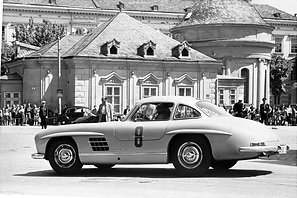In February 1954, the 300 SL production sports car (W 198) made its debut at the International Motor Sport Show in New York. The high-performance sports car is also known as the "Gullwing" or "Papillon" (butterfly) because of its characteristic gullwing doors attached to the roof. The spectacular vehicle was based on the legendary 300 SL racing sports car (W 194) from the 1952 season. Max Hoffman – an American car dealer of Austrian origin who had been the importer for Mercedes-Benz passenger cars in the USA since September 1952 – had persuaded the Daimler-Benz Board of Management during a visit to Untertürkheim in September 1953 to put the successful 300 SL racing sports car into production.
Essential elements of this first newly developed Mercedes-Benz racing car of the post-war era were adopted for the production version: This was primarily due to the chassis with its lightweight and torsionally rigid tubular frame, which however built tall in the entrance area and made the publicity-grabbing gullwing doors necessary. The engine of the W 198 was even more powerful than in the racing version: For the first time in a production passenger car with a four-stroke engine, the innovative petrol injection system, previously only used in aircraft engines, was responsible for mixture formation. The so-called "Hobel" – the 300 SL racing sports car for the 1953 season – was already equipped with the fuel-injected version of the 3-litre six-cylinder engine, but it was not used in racing.
The elegantly designed bodywork, which chief stylist Friedrich Geiger had developed from the racing car through extensive refinement, was fundamentally revised. With an engine output of 215 hp/158 kW – a good 20 per cent more than the carburettor-equipped racing version from 1952 – and a top speed of up to 250 km/h, the W 198 was in the top range of production sports cars of its time, which also predestined it for sporting applications.
The 300 SL production sports car's triple class victory in the 1955 Mille Miglia, the W 198's first motorsport outing, remains legendary to this day. John Cooper Fitch and his co-driver Kurt Gessl finished fifth overall in car number 417, which stands for the start time at 4:17 h, and led the class of production sports cars with a displacement of more than 1.3 litres ahead of two other "Gullwing" cars. However, this spectacular result was only the prelude to numerous other motorsport successes for the 300 SL.
These included the overall victories in 1955 by Hans Tak and W.C. Niemöller in the Tulip Rally at the beginning of May, by Olivier Gendebien in the Coppa d'Oro delle Dolomiti on 10 July, by Werner Engel and Horst Straub in the Rallye Adriatique from 20 to 24 July, by Olivier Gendebien and Pierre Stasse in the Liège–Rome–Liège Rally from 17 to 21 August and Olivier Gendebien and Gilberte Thirion in the Stella Alpina Rally from 25 to 28 August. Karl Kling won the GT class in the Swedish Grand Prix on 7 August. In this first motorsport year of the W 198, Werner Engel became European touring car champion, using a 220 "Ponton" in addition to the 300 SL, and Paul O'Shea won the American Sports Car Club (SCCA) championship in category D in a 300 SL.
The 1956 season was no less successful for the 300 SL and its drivers: Walter Schock and Rolf Moll won the overall classification of the Rally Sestriere from 24 to 28 February and the Acropolis Rally from 26 to 29 April. Schock also won the ADAC Eifel Race on 26 August, and victory in the Liège–Rome–Liège Rally from 29 August to 2 September went to Willy Mairesse and Marc Genin. In addition, there were numerous class victories in races and rallies, and three W 198s took 6th to 8th place overall in the Mille Miglia at the end of April. Walter Schock and Rolf Moll became European touring car champions in a 300 SL and 220 "Ponton", and Paul O'Shea won the American Sports Car Club (SCCA) championship in category D again in a 300 SL. In 1957, the 300 SL "Gullwing" was still winning numerous class victories in rallies and races all over the world.
The 300 SL used by the works team or with works support was generally a weight-reduced version with a light-alloy body that weighed around 80 kilograms less. In 1955 and 1956, a total of 29 examples of this light-alloy coupé were built, which are now considered particularly sought-after collector's items.


